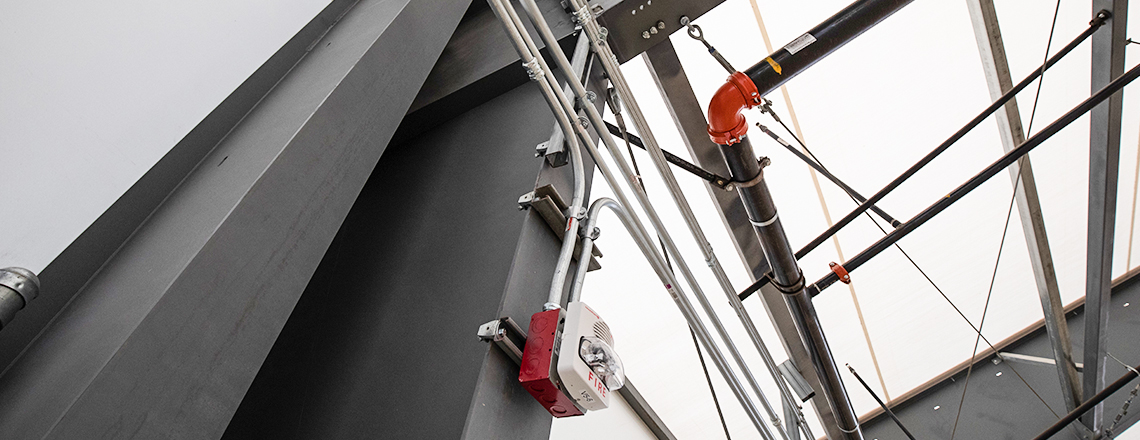Fire-Rated Fabric: Ensuring Fire Safety in Tension Fabric Structures

In this blog series, our Legacy team of engineers will answer questions that were submitted during recent webinars. Today’s questions address fire safety in fabric buildings.
Q. Is the fabric fire-rated by the National Fire Protection Association (NFPA)?
A. Legacy’s ExxoTec™ PVC fabric meets NFPA 701, California State Fire Marshal and ASTM 84 building code requirements.
The NFPA 701 flame tests determine whether or not the fabric self-extinguishes or not. Self-extinguishing fabric is important as it does not add fuel to the fire.
When exposed directly to flame, ExxoTec™ will shrink away from the fire. As the fabric pulls away, it creates ventilation for the smoke and heat, meaning the two of the primary sources of fire damage are allowed to escape. This ventilation saves crucial seconds during a fire.
Additionally, the ASTM E-84 smoke development test determines the amount of smoke that is developed from the fabric during a fire. ExxoTec™ fabric has a Class A rating for smoke development.
Allowing heat to escape also reduces the risk of damage to the building's structural integrity. In many cases, this allows the building owner to simply re-cover the existing building frame, rather than rebuilding from the ground up – saving weeks or months of lost time and money, as well as providing protection from the elements for the building's assets.
Q. Are fabric buildings flammable?
A. The fabric is fire rated, which means it does not burn. In a fire event, the fabric melts away, allowing the heat to escape and drastically reducing the damage to the building. The ventilation also provides an escape route for smoke, which is one of the most deadly elements of a fire. Ventilation also minimizes the impact of the heat and smoke on the building frame and contents.

Q. Are fire protection sprinklers typically installed in these buildings? Are they required?
A. Sprinkler systems are typically required based on the building application rather than the building material. Sprinklers can be added as needed. Water deluge or ATTT systems are available.
See an example of a fabric building with a fire suppression system.
Combining ExxoTec™ fabric with a fire suppression system fights the fire on two fronts: The fire suppression system works to stop the fire. The fabric can shrink away from the heat, allowing smoke and heat to escape the building, and also time for people to escape and for firefighters to arrive on the scene and put the fire out.
Q. Does the fabric meet NFPA 701 fire propagation performance criteria?
A. Yes. It is required by building code.
Learn more about our exclusive ExxoTec PVC fabric.
Q. How are fabric buildings rated by the NFPA?
A. By nature and definition, fabric structures are classified as Group IV buildings by the National Fire Protection Administration. Group IV buildings with less than 12,000 square feet of fire area do not require a sprinkler.
Q. How are these structures rated for fire classification and calculation of required fire flow for fire protection?
A. Fabric buildings with ExxoTec™ fabric (meeting NFPA 701 Test Method 2) are classified as Type II B buildings.
Q. Do you have examples of fabric structures with fire protection (i.e., sprinklers)?
A. We have several examples of tension fabric structures with fire protection and sprinklers across many industries. Some examples include sports centers, hangars, storage buildings and manufacturing facilities.

Q. How does your structure carry fire protection for the type of structure as a hangar use?
A. Fire protection loads are designed into the rigid steel frame and subframe design specific to each project. Our buildings that have fire protection systems have special frame designs to support the weight.
Airplane and equipment hangars have long relied on the benefits of flame-retardant material to provide some level of fire protection.
Hangars are required to comply with NFPA 409. The purpose of the regulation is “to provide a reasonable degree of protection from fire for life and property in aircraft hangars, based on sound engineering principles, test data and field experience.”
See more advantages of fabric buildings for aviation.
By nature and definition, fabric buildings are classified as a Group IV according to NFPA 409. Depending on the size of the building and other factors, this often means reduced requirements for fire suppression systems. For this reason, airport authorities will often choose fabric buildings over other options such as a metal building.
Q. Are any other materials available to enhance the fire protection of a fabric building?
A. Alternate cladding options include one- to two‐ hour fire‐rated walls. Before choosing any type of alternate cladding, your project design representative will discuss the new material and how it will impact your fire suppression needs.
Do you have more questions about fire safety or other aspects of fabric buildings?
Contact us to get the answers you need.
Subscribe to our Blog
Recent Posts
- 5 Factors Every Project Owner Should Consider Before Approving Building Materials
- The 20-Year View: How Material Choices Impact Long-Term Operational Costs
- Climate Resilience in Commercial Construction: Why Traditional Methods May Not Be Enough
- Speed and Quality: The Role of Hybrid Building Materials
- Beyond the Bleachers: Designing Visually Striking Sports Facilities
